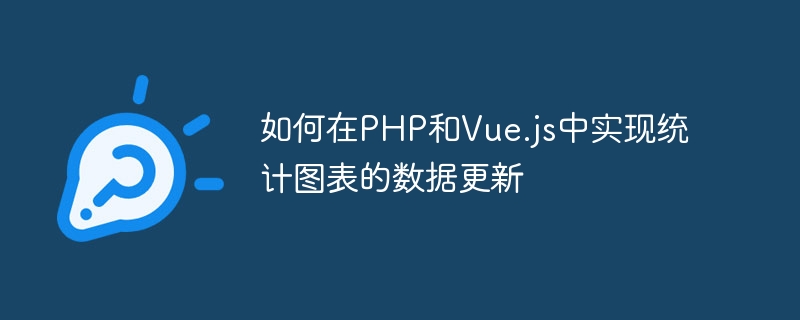

How to implement data update of statistical charts in PHP and Vue.js
With the increasing demand for data analysis and visualization, the role of statistical charts in web applications Applications are becoming more and more widespread. In this process, PHP and Vue.js are two commonly used technology frameworks. This article will introduce how to combine PHP and Vue.js to update the data of statistical charts so that the latest data can be displayed in real time.
Before we start, we need to prepare some basic tools and environment. First, make sure you have a development environment for PHP and Vue.js installed. Secondly, you need a PHP backend server with a data interface, and a front-end Vue.js application.
Next, we will proceed step by step.
Step 1: Prepare the data interface
In the PHP backend, we need to create a data interface to provide the data that needs to be displayed. We can use PHP's database access extensions such as PDO or mysqli to query data, and then return the query results to the front end in JSON format. Here is a simple example:
<?php
// 连接数据库
$pdo = new PDO('mysql:host=localhost;dbname=test', 'username', 'password');
// 查询数据
$stmt = $pdo->prepare("SELECT * FROM statistics");
$stmt->execute();
$data = $stmt->fetchAll(PDO::FETCH_ASSOC);
// 返回JSON数据
header('Content-Type: application/json');
echo json_encode($data);
?> In the above example, we connected to a MySQL database named test and queried the database named statistics All data in the table. We then return the query results to the front end in JSON format.
Step 2: Build a Vue.js application
Next, we need to build a Vue.js application to display statistical charts and update data in real time.
First, introduce the Vue.js and statistical chart library files into the HTML file.
<script src="https://cdn.jsdelivr.net/npm/vue@2.6.14/dist/vue.js"></script> <script src="https://cdn.jsdelivr.net/npm/echarts@5.2.2/dist/echarts.min.js"></script>
Then, define the data and methods in the Vue instance.
<div id="app">
<div ref="chart" style="width: 600px; height: 400px;"></div>
</div>
<script>
new Vue({
el: '#app',
data: {
chart: null,
data: []
},
mounted() {
this.chart = echarts.init(this.$refs.chart);
this.getData();
},
methods: {
getData() {
fetch('api.php') // 调用PHP接口
.then(response => response.json())
.then(data => {
this.data = data;
this.updateChart();
});
},
updateChart() {
// 更新图表数据并重新渲染
const option = {
// 图表配置参数
series: [{
data: this.data
}]
};
this.chart.setOption(option);
}
}
});
</script>In the above code, we define a Vue instance, which contains a Div element identified as chart, used to display statistical charts. In the mounted life cycle hook, we initialize an echarts instance and call the getData method to obtain data. In the getData method, we use the fetch function to call the PHP interface to obtain the data, and after the data is returned, call the updateChart method to update the chart.
Step 3: Update data in real time
In order to update data in real time, we can use a timer to call the getData method regularly to obtain the latest data and update the chart.
Add the following code in the mounted life cycle hook of the Vue instance:
setInterval(() => {
this.getData();
}, 5000); // 每5秒更新一次数据The above code will execute the getData method every 5 seconds , and update the chart.
So far, we have completed the process of updating the data of statistical charts in PHP and Vue.js.
Summary
This article introduces how to update the data of statistical charts in PHP and Vue.js. By using PHP to provide a data interface and combining it with Vue.js to build a front-end application, we can display the latest data and update charts in real time. This method is not only simple and easy to understand, but also very flexible and can be applied to various types of data statistical chart applications.
I hope this article will be helpful to developers who want to update statistical chart data in PHP and Vue.js.
The above is the detailed content of How to implement data update of statistical charts in PHP and Vue.js. For more information, please follow other related articles on the PHP Chinese website!